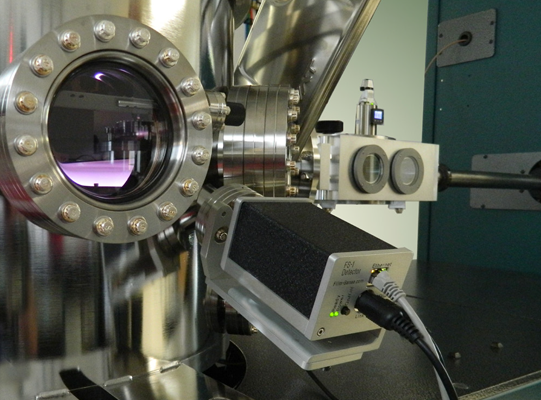University of Connecticut
Film Sense In Situ Ellipsometer Integration details
written by Necmi Biyikli – Assistant Professor, Electrical and Computer Engineering, UCONN
Being active in ALD research since 2010, our conventional growth recipe development and saturation curve studies looked like this: grow a 300-cycle film at a given growth condition, take the sample to the ellipsometer lab, characterize the film thickness and optical constants, load another sample for another 300-cycle run with a single parameter difference. Such a parametric saturation curve study took easily a week for a single compound, while being affected by atmospheric exposure for ex-situ optical measurements. Moreover, we were completely blind in terms of how the film growth process initiated and evolved during the deposition cycles, particularly whether there is any nucleation delay or substrate-enhanced growth mode.
An in-situ ellipsometer was a very attractive tool for us, however the financial burden was beyond our capacity. I believe it was only shortly after Film Sense started to appear in AVS conferences that it was a perfect match for our needs within our budget limits. In 2015, we purchased the FS-1 tool for ex-situ only use as our ALD reactors did not have ellipsometer ports. Even in ex-situ mode, FS-1 roved to be very handy and easy to use for quick checks where we did not need the more time-consuming spectroscopic data analysis. Moreover, FS-1 was very useful in quickly mapping the optical constants over 4-6” diameter wafers and obtaining the uniformity maps for our ALD coatings.
Unfortunately, we didn’t have the opportunity to modify our reactors to integrate the in-situ accessories for the FS-1 tool in 2016. However, when I started my next position at The University of Connecticut, I did not even hesitate to include the budget for a new FS-1 system that I could integrate on both OkyayTechALD thermal and hollow-cathode plasma reactors. The systems were installed early 2018 and after some effort to figure out the new reactor operation modes we were able to use the FS-1 indeed very effectively. Since then, almost in every deposition experiment, we have been observing our ALD growth cycles in real-time which provides us a very valuable finger-print of the film growth behavior. A typical saturation curve study for a new precursor/material takes merely a day of continuous 10-cycle runs, without even needing to unload the substrate. Another very advantageous aspect of FS-1 system is the sub-angstrom resolution that is particularly needed for nucleation inhibition/delay studies for area-selective deposition experiments.
To summarize our nearly 5-year ownership experience of the FS-1 tool, all I can say, it’s most probably by far the highest performance/cost tool I have ever acquired in my independent research career. Besides the tool itself, as an ellipsometry expert, Film Sense has been very responsive to our data analysis/fit inquiries and saved us valuable research time by sharing his expertise. We are looking forward to get their last generation system with additional features that we can integrate for good on either of the reactors. Right now, our single FS-1 tool is going back-and-forth between thermal and plasma reactor based on our needs.
If you want to get real-time deposition data for your films at a very reasonable cost, I would bet you can’t beat Film Sense systems. Film Sense is definitely the in-situ/ex-situ ellipsometer partners for your process monitoring and optical characterization needs.
– Necmi Biyikli, Assistant Professor, Electrical and Computer Engineering, University of Connecticut
Film Sense In Situ Application Examples
The FS-1 has been installed for in situ measurements on many different ALD reactors, including custom designs, and commercial reactors from the companies below.


